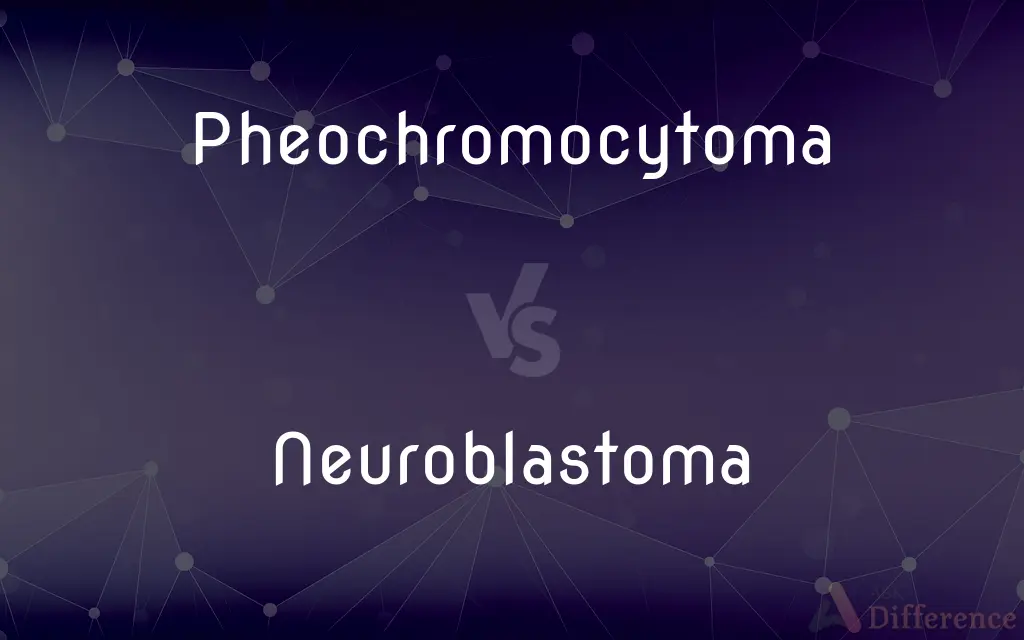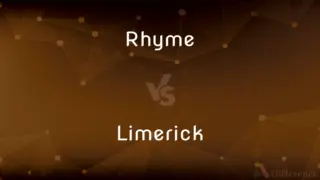Pheochromocytoma vs. Neuroblastoma — What's the Difference?
Edited by Tayyaba Rehman — By Fiza Rafique — Updated on September 29, 2023
Pheochromocytoma is a rare tumor of the adrenal gland's chromaffin cells, while neuroblastoma is a cancer originating from immature nerve cells in children.

Difference Between Pheochromocytoma and Neuroblastoma
Table of Contents
ADVERTISEMENT
Key Differences
Pheochromocytoma and neuroblastoma are both tumors but originate from different cells and affect distinct age groups. Pheochromocytoma arises from the chromaffin cells of the adrenal gland, typically in adults. In contrast, neuroblastoma stems from immature nerve cells and is most commonly diagnosed in children.
The symptoms and manifestations of pheochromocytoma can differ significantly from neuroblastoma. Individuals with pheochromocytoma often experience high blood pressure, sweating, and rapid heart rate due to the tumor's secretion of catecholamines. Neuroblastoma, on the other hand, presents with a mass in the abdomen, bone pain, or other symptoms based on its location.
Diagnostic tools and approaches for pheochromocytoma and neuroblastoma vary. For pheochromocytoma, tests often involve blood and urine samples to measure catecholamine levels. In the case of neuroblastoma, imaging studies and biopsy procedures are commonly employed.
Treatment strategies for pheochromocytoma frequently focus on surgical removal of the tumor, followed by specific medications if needed. In contrast, neuroblastoma treatment can be multifaceted, involving surgery, chemotherapy, radiation, and sometimes immunotherapy.
The prognosis for both pheochromocytoma and neuroblastoma can vary based on several factors. Early detection and treatment of pheochromocytoma often result in good outcomes. Meanwhile, the prognosis for neuroblastoma can range from favorable to high-risk, depending on the tumor's characteristics and the patient's age.
ADVERTISEMENT
Comparison Chart
Origin
Chromaffin cells of the adrenal gland
Immature nerve cells
Common Age Group
Adults
Children
Common Symptoms
High blood pressure, sweating, rapid heart rate
Abdominal mass, bone pain, various symptoms
Diagnostic Approaches
Blood and urine catecholamine tests
Imaging, biopsy
Treatment Methods
Surgery, medications
Surgery, chemotherapy, radiation, etc.
Compare with Definitions
Pheochromocytoma
A rare tumor arising from adrenal gland chromaffin cells.
The patient was diagnosed with a pheochromocytoma in her left adrenal gland.
Neuroblastoma
A cancer originating from immature nerve cells.
The young child was diagnosed with neuroblastoma.
Pheochromocytoma
Often secretes excess catecholamines.
Due to the pheochromocytoma, she experienced severe hypertension.
Neuroblastoma
Most commonly diagnosed in children.
Neuroblastoma is a leading cause of cancer in infants.
Pheochromocytoma
Can cause high blood pressure and palpitations.
He sought medical help when pheochromocytoma symptoms became severe.
Neuroblastoma
Can metastasize to bones and other organs.
The neuroblastoma had spread to his bones.
Pheochromocytoma
Mainly affects adults.
Pheochromocytomas are uncommon in pediatric patients.
Neuroblastoma
Treated with a combination of therapies.
The treatment plan for her neuroblastoma included chemotherapy and surgery.
Pheochromocytoma
Typically treated with surgical removal.
The surgical team successfully removed the pheochromocytoma.
Neuroblastoma
Presents with varied symptoms based on location.
The mass in her abdomen was due to neuroblastoma.
Pheochromocytoma
Pheochromocytoma (PHEO or PCC) is a rare tumor of the adrenal medulla composed of chromaffin cells, also known as pheochromocytes. When a tumor composed of the same cells as a pheochromocytoma develops outside the adrenal gland, it is referred to as a paraganglioma.
Neuroblastoma
Neuroblastoma (NB) is a type of cancer that forms in certain types of nerve tissue. It most frequently starts from one of the adrenal glands but can also develop in the neck, chest, abdomen, or spine.
Pheochromocytoma
A usually benign tumor of the adrenal medulla or the sympathetic nervous system in which the affected cells secrete increased amounts of epinephrine or norepinephrine.
Neuroblastoma
A malignant tumor composed of neuroblasts, originating in the autonomic nervous system or the adrenal medulla and occurring chiefly in infants and young children.
Pheochromocytoma
(medicine) A neuroendocrine tumour of the medulla of the adrenal glands.
Neuroblastoma
(oncology) A form of cancer that affects the ganglia in various parts of the body
Pheochromocytoma
A vascular tumor of the adrenal gland; hypersecretion of epinephrine results in intermittent or sustained hypertension
Neuroblastoma
Malignant tumor containing embryonic nerve cells; usually metastasizes quickly
Common Curiosities
How common is neuroblastoma in children?
Neuroblastoma accounts for about 6% of all cancers in children.
How is pheochromocytoma diagnosed?
Pheochromocytoma is often diagnosed through blood and urine tests measuring catecholamine levels.
Can pheochromocytoma symptoms mimic other conditions?
Yes, pheochromocytoma can mimic various conditions due to its effect on blood pressure and heart rate.
What causes neuroblastoma?
The exact cause is unknown, but genetic mutations play a role in neuroblastoma's development.
Are pheochromocytomas cancerous?
Most pheochromocytomas are benign, but some can be malignant.
Is neuroblastoma hereditary?
While most cases are sporadic, some neuroblastoma cases have a hereditary component.
Are there risk factors for developing pheochromocytoma?
While it can occur sporadically, some genetic conditions increase the risk of pheochromocytoma.
How aggressive is neuroblastoma?
Neuroblastoma's aggressiveness varies, with some tumors being low-risk and others being high-risk.
Can pheochromocytoma be life-threatening?
If untreated, pheochromocytoma can lead to severe complications due to high blood pressure.
At what age is neuroblastoma typically diagnosed?
Neuroblastoma is most often diagnosed before age 5.
Are there stages for neuroblastoma?
Yes, neuroblastoma is staged based on tumor size, location, and spread.
Are there lifestyle changes to manage pheochromocytoma symptoms?
Patients may need to modify their diet, reduce stress, and avoid certain medications.
What are the complications of untreated pheochromocytoma?
Complications can include heart disease, stroke, and organ damage.
Can pheochromocytoma recur after treatment?
While rare, pheochromocytoma can recur, making regular follow-ups crucial.
What research is being done on neuroblastoma?
Research includes new treatment methods, genetic factors, and ways to reduce side effects.
Share Your Discovery

Previous Comparison
Rhyme vs. Limerick
Next Comparison
Confidentiality vs. DiscretionAuthor Spotlight
Written by
Fiza RafiqueFiza Rafique is a skilled content writer at AskDifference.com, where she meticulously refines and enhances written pieces. Drawing from her vast editorial expertise, Fiza ensures clarity, accuracy, and precision in every article. Passionate about language, she continually seeks to elevate the quality of content for readers worldwide.
Edited by
Tayyaba RehmanTayyaba Rehman is a distinguished writer, currently serving as a primary contributor to askdifference.com. As a researcher in semantics and etymology, Tayyaba's passion for the complexity of languages and their distinctions has found a perfect home on the platform. Tayyaba delves into the intricacies of language, distinguishing between commonly confused words and phrases, thereby providing clarity for readers worldwide.
















































